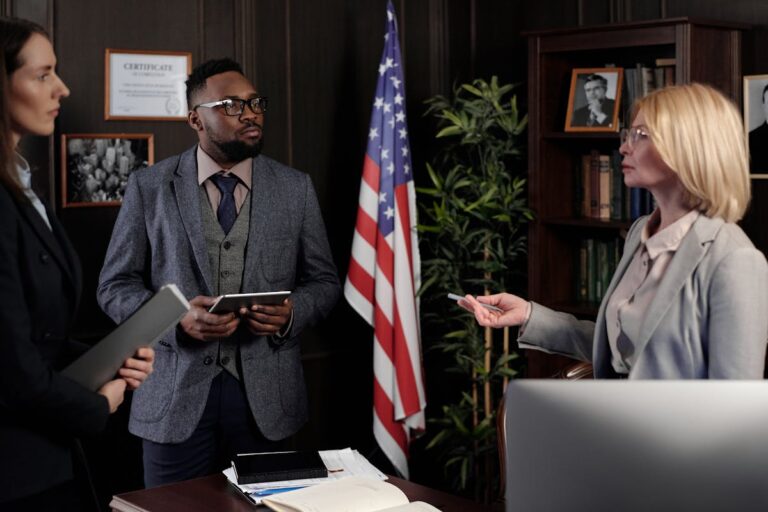Legal Options When Your Business Partner Acts in Bad Faith
Business partnerships can deteriorate when one party engages in bad faith conduct. When financial impropriety, unauthorized actions, or breaches of fiduciary duty emerge, legal intervention becomes necessary. Partners facing such situations have multiple options: mediation, contractual enforcement, fiduciary duty claims, injunctive relief, or dissolution proceedings. The appropriate strategy depends on the severity of misconduct, desired outcomes, and relationship salvageability. Understanding these legal remedies provides essential protection for business owners confronting partnership betrayal.
Recognizing Bad Faith Actions in Business Partnerships
Numerous business partnerships dissolve due to bad faith actions that undermine trust and contractual obligations. Bad faith occurs when a partner deliberately violates their fiduciary duties through deception, self-dealing, or concealment of material information. Common indicators include unexplained changes in profit distributions, unauthorized contract executions, and exclusion from critical business decisions.
Financial impropriety often signals bad faith. Identifying suspicious financial transactions requires vigilant review of company records, including unexplained withdrawals, manipulated expense reports, or unusual payment patterns. Similarly, detecting signs of embezzlement involves recognizing discrepancies between reported revenue and actual cash flow, altered financial documents, or unrecorded business transactions. Partners should also be alert to sudden resistance to financial transparency, diversion of business opportunities, or misrepresentation to third parties.
Documenting Evidence of Partner Misconduct
To establish a business partner’s bad faith actions, thorough documentation serves as the foundation for any legal recourse. Financial records can reveal unauthorized transactions, diverted funds, or other fiscal improprieties that substantiate claims of misconduct. A systematic record of all communications paired with a chronological timeline of partnership breaches strengthens the evidentiary basis required for successful legal intervention.
Gather Financial Records
When confronting a business partner suspected of bad faith actions, detailed financial documentation serves as the cornerstone of any legitimate legal claim. Business owners should systematically review bank statements to identify unauthorized transactions, suspicious transfers, or irregular withdrawals that deviate from established operating procedures.
Legal counsel typically advises clients to scrutinize accounting records for discrepancies between reported earnings and actual revenues. This includes examining:
- Company credit card statements
- Tax filings and quarterly reports
- Expense reimbursement requests
- Vendor payment histories
- Profit distribution records
Financial forensics may reveal patterns of self-dealing, misappropriation of company assets, or deliberate manipulation of financial statements. Courts give substantial weight to quantifiable evidence that demonstrates concrete financial impact rather than subjective allegations. Maintaining an unbroken chain of financial documentation considerably strengthens potential litigation or settlement negotiations.
Track Communication History
How business partners communicate often reveals critical evidence of their intentions and actions. Business owners should meticulously document all exchanges with partners suspected of bad faith conduct, preserving emails, text messages, and records of verbal conversations. This documentation establishes a chronological pattern of behavior that may substantiate legal claims.
When building this communication history, attorneys recommend parties review email logs for promises made or broken, contradictory statements, or attempts to conceal information. Similarly, parties should monitor joint account activity for unauthorized transactions or suspicious patterns. Regular screenshots of account balances and transaction histories provide timestamped evidence that may prove invaluable in litigation.
Contemporaneous notes from meetings and phone calls, including dates, participants, and key discussion points, further strengthen the evidentiary record needed to demonstrate bad faith conduct.
Establish Breach Timeline
Building on thorough communication tracking, a structured breach timeline serves as the backbone of any legal action against a business partner. Attorneys recommend organizing evidence chronologically, noting each instance of questionable conduct alongside supporting documentation. This timeline should identify pivotal moments when the partner deviated from contractual obligations or fiduciary duties.
When establishing timeline documentation, include dates of verbal discussions, written agreements, suspicious financial transactions, and unauthorized business decisions. Cross-reference these events with communication records to demonstrate patterns of misconduct rather than isolated incidents. Courts evaluate bad faith claims based on extensive evidence of deliberate breaches over time, not singular disagreements.
A meticulously constructed timeline transforms scattered documentation into a compelling narrative that demonstrates the systematic nature of a partner’s misconduct, significantly bolstering the legal position of the aggrieved party.
Initiating Partnership Dispute Resolution Procedures
When facing partner misconduct, businesses should first review their partnership agreement for mandatory dispute resolution provisions. Formal mediation offers a structured yet less adversarial environment where neutral third parties facilitate negotiations before litigation becomes necessary. Enforcement of contractual remedies typically follows a progressive sequence of steps outlined in operating agreements, including notice periods, cure provisions, and specific performance requirements.
Formal Mediation Procedures
Three critical steps exist for initiating formal mediation when partnership disputes escalate beyond informal resolution. First, partners must review their operating agreement for specific alternative dispute resolution provisions, which typically outline the required mediation framework. Second, selection of a qualified mediator with business partnership expertise occurs either by mutual agreement or through a professional association’s appointment process.
Third, partners must execute a confidential mediation agreement establishing ground rules, including: information disclosure requirements, session structure, cost allocation, and confidentiality parameters. This agreement creates a protected environment where potentially sensitive business information remains privileged.
The formal mediation process typically requires preparation of position papers and documentation of disputed actions, enabling the mediator to facilitate constructive dialogue toward a binding or non-binding resolution without immediate court intervention.
Contractual Remedy Enforcement
Most partnership agreements contain specific contractual remedies that provide structured pathways for resolving disputes when a partner acts in bad faith. These provisions typically outline sequential steps for enforcement, beginning with formal notice requirements and escalating to binding resolution mechanisms.
A thorough partnership agreement review is essential to identify all available remedies, including buy-sell provisions, forced dissolution options, or mandatory buyout clauses. Financial audit considerations often play a critical role in this process, as they can document discrepancies, misappropriation of assets, or breaches of fiduciary duty. Courts generally enforce these contractual remedies when properly invoked.
Business owners should meticulously follow the procedural requirements specified in their agreements when initiating enforcement actions, as procedural missteps may compromise otherwise valid claims.
Pursuing Breach of Fiduciary Duty Claims
Why do breach of fiduciary duty claims often provide the strongest legal recourse against a partner operating in bad faith? Unlike contractual claims, fiduciary duty actions address the fundamental trust relationship inherent in business partnerships. Partners owe each other the highest standard of care, loyalty, and honesty under law.
Business owners have specific owner obligations that transcend written agreements. These fiduciary duties include acting in the partnership’s best interest, disclosing material information, avoiding self-dealing, and maintaining confidentiality. Courts typically impose stricter penalties for fiduciary breaches than contract violations, including punitive damages and potential disgorgement of profits.
The legal standard for proving these breaches—typically preponderance of evidence—is also more favorable to plaintiffs than many other business claims, making fiduciary duty actions particularly potent when confronting partner misconduct.
Seeking Injunctive Relief to Prevent Further Harm
Injunctive relief serves as a critical immediate remedy when a business partner’s bad faith actions threaten ongoing or irreparable damage to the business. Courts may grant such relief when monetary damages would prove inadequate to address the harm being caused.
The process typically begins with seeking a temporary restraining order, which provides immediate but short-term protection against specified harmful activities. This emergency measure requires demonstrating likelihood of irreparable harm without court intervention. If granted, it remains effective until a hearing for a preliminary injunction can occur.
A preliminary injunction provides longer-term protection while the underlying legal dispute proceeds through litigation. To obtain this remedy, the aggrieved partner must establish probability of success on the merits, balance of hardships favoring relief, and that public interest supports the injunction.
Filing for Judicial Dissolution of the Partnership
While injunctive relief addresses immediate threats to business operations, more severe situations may warrant the ultimate legal remedy: dissolution of the partnership itself. When a partner’s bad faith conduct fundamentally undermines the business relationship, courts may order judicial dissolution under state partnership laws.
This process requires petitioners to demonstrate irreconcilable differences, fiduciary breaches, or operational deadlock that render continued partnership impossible. Courts examine whether partnership termination alternatives—such as buyouts, restructuring, or mediation—have been exhausted before granting dissolution.
Dissolution timeline considerations include asset valuation, debt settlement, and client changeover periods. Courts typically appoint receivers to oversee the winding-down process, ensuring equitable distribution of assets and minimizing disruption. The entire dissolution typically spans three to twelve months, depending on business complexity and partner cooperation.
Negotiating a Partnership Buyout Agreement
A buyout agreement represents a strategic alternative to dissolution, allowing one partner to purchase another’s ownership interest while preserving the business entity. When negotiating such agreements in bad faith situations, parties should establish clear partnership valuation methods—potentially engaging independent appraisers to determine fair market value and prevent undervaluation disputes.
The agreement should address payment structures, including lump sum options versus installment payments with appropriate security provisions. Terms must guarantee equitable distribution of assets while accounting for contributions, liabilities, and potential future earnings. Time-sensitive provisions may prevent the departing partner from competing or soliciting clients.
Parties should document all negotiations and consider mediation to facilitate discussions. Even when relations are strained, a well-structured buyout agreement can provide a clean separation while maintaining business continuity.
Recovering Damages Through Civil Litigation
Many businesses victimized by partner misconduct ultimately pursue civil litigation to recover financial losses and secure appropriate remedies. Courts provide structured pathways for damage recovery when partnership agreements are breached or fiduciary duties violated. Compensatory, consequential, and occasionally punitive damages may be available depending on jurisdiction and misconduct severity.
Effective lawsuit preparation requires meticulous documentation of all breaches, financial impacts, and communication attempts to resolve disputes. Plaintiffs must establish causation between the partner’s bad faith actions and quantifiable business losses. Courts typically require demonstration that damages were reasonably foreseeable consequences of the misconduct.
Most jurisdictions allow recovery for lost profits, provided they can be proven with reasonable certainty through financial records, expert testimony, and market analysis rather than speculative projections.
Implementing Business Continuity Strategies Post-Dispute
Successful businesses invariably develop thorough continuity plans after partnership disputes threaten operational stability. These organizations recognize that risk mitigation extends beyond legal resolution to encompass operational safeguards that preserve enterprise value. Effective continuity strategies typically include reassignment of key responsibilities, preservation of institutional knowledge, and protection of client relationships.
Contingency planning should address potential leadership vacuums, intellectual property concerns, and contractual obligations that may be jeopardized by partner misconduct. Organizations often establish communication protocols to maintain stakeholder confidence during shifts. Many businesses implement temporary governance structures with clearly defined decision-making authorities while permanent arrangements are formalized.
The most resilient recovery strategies involve documenting operational workflows, securing access to critical systems, and maintaining financial reserves sufficient to weather changeover disruptions—thereby ensuring business viability despite partnership dissolution.
Frequently Asked Questions
Can I Recover Legal Fees When Suing a Bad Faith Partner?
Recovery of legal fees when suing a partner for bad faith actions may be possible through contingency fee arrangements. Success often depends on securing evidence of wrongdoing and applicable contractual provisions or statutory allowances.
How Long Do Partnership Dispute Lawsuits Typically Take to Resolve?
Partnership dispute lawsuits typically take 12-24 months to resolve, depending on case complexity, filing timeline, and court procedures. Factors affecting duration include discovery phase length, motion practice, settlement negotiations, and court backlog in the jurisdiction.
Will My Personal Assets Be Vulnerable During Partnership Litigation?
Personal assets may be vulnerable during partnership litigation depending on business structure. Maintaining separate personal savings and monitoring bank account activity regularly are essential protective measures against potential legal exposure or unauthorized withdrawals.
Can Criminal Charges Be Filed Against a Fraudulent Partner?
Criminal prosecution options exist when partners commit fraud, particularly if actions involve theft, embezzlement, or misrepresentation. Authorities may pursue charges independently of potential civil claims, which remain available remedies for the injured party.
How Can I Protect My Business Reputation During Partnership Disputes?
When partnership disputes arise, developing a public relations strategy is essential. Implementing online reputation management techniques helps maintain stakeholder confidence. Companies should communicate transparently while refraining from disparaging statements about ongoing business disagreements.







